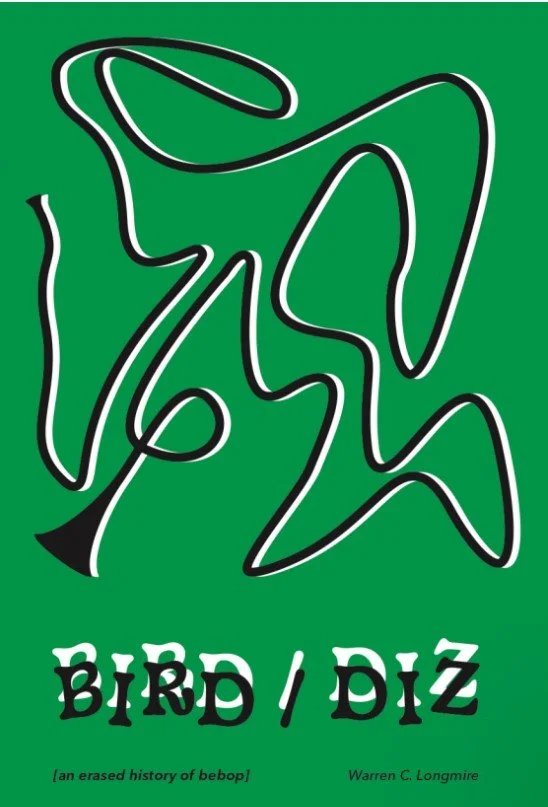Bird/Diz [an erased history of bebop]
Bunny Presse
$13.00
You can purchase a copy here.
Reviewed by Sean Hanrahan
Jazz is an elusive art to capture in words. How can a poet hope to capture its complexity, or its unwillingness to be trapped in mere description? In his second book, Bird/Diz [an erased history of bebop], Warren C. Longmire accomplishes this feat through a fascinating collection of erasure poems focusing on two influential jazz musicians, Charlie “Bird” Parker and John Berks “Dizzy” Gillespie. Performing his unique poetic alchemy, Longmire captures the essence, the ecstaticity of jazz. Quite simply, he transforms words into gold.
Although Bird/Diz amply celebrates both Parker and Gillespie, Longmire writes erasure odes to other jazz greats who may not be as well known. In “An Open Mic. Hood Bar Full of Black Folk,” he employs erasure poetry to great effect as he celebrates the unsung former saxophone player, Henry Minton, who
opened this small club for people.
Meet and relax and if you like
play there. Even
the kids on the sidewalk danced.
On the opposite side of the page is a beautifully rendered erasure of this article which celebrates the joy of jazz. In this poem, Longmire also celebrates the continuity of jazz, through the evocative image of kids dancing on the sidewalk.
In one of the non-erasure (prose) poems found in this collection, “Sarah Vaughn (1959)” captures his search for videos of jazz musicians on You Tube: “3 mins and 31 seconds into the earliest recording of Sarah Vaughn I can find and I am so bored.” This video is the build up to Vaughn’s performance at “the swanky ballroom of Playboy mansion” where comedian, Marty Ingles, is holding up the show: “Marty is STILL talking, now on an imaginary phone having a fake conversation with a Chicago tollbooth putting a lean on his house.” Finally, Vaughn gets her opportunity to wow Hugh Hefner and his friends as the reader’s and Longmire’s interest pique into a fabulous crescendo:
The song she sings for the Playboy Mansion is similar.
“Misty.” How she’s as helpless as a kitten in a tree. A sleight-of-hand
man who appears after says:
Well look, Hef, of course I love her. She’s the best.
The girl hits me right in the middle.
Right in the jangling purse I have hidden inside my breast.
In several of these poems, Longmire erases the name of the jazz musician themselves. In “Playing and Talking. Eating and Drinking,” Longmire uses this erasure to compare the musical styles of both Gillespie and Parker. An erased Dizzy’s “neck inflates balloon. All of which is no matter. No physical. That’s just the way he played.” “Sometimes [erased Parker] became the idea of trumpet. Playing less unison section [erased Parker] set on translating it to modern for club, work, eventual band, and nobody.” Another element of this poem to mention is that the erasures themselves are two different styles mirroring the different styles of Gillespie and Parker. Gillespie’s erasure is mostly blacked out with just the relevant words uncovered. In Parker’s erasure, the article text has zebra lines running through it where the relevant words are boxed in. Needless to say, this book is as much a visual treasure as it is a written one.
The whole ebb and flow of erasure and celebration comes to a glorious counterpoint in “Boy, That Cat Sound, You Know? He’s Fast Becoming My Favorite!” The erasure on the left side of the page is a picture of Gillespie’s head covered by text. The poem starts with the source text: “Including Verve. Including Quincy Jones and Jones for short. Including Dizzy. Picture of Dizzy called “The High Priest of Bebop. Taken in Nice.” It then goes on to say what has been excluded “Excluding indications of arrangement (most scratched with exacto)”…”Excluding initial before anger/Excluding ‘has subsidized after anger’/Including anger. Capitalizing it.” This poem has such a rhythmic forcefulness and obvious love of jazz that I am left stunned every time I read it.
Bird/Diz ends on such a joyful note with “Dizzy Gillespie (1981).” As a poet, Longmire is a celebrator of Black life and culture and an uplifter in a time when that is so necessary. Every time I read this poem it puts a smile on my face. With lines such as “Starting with a cane bangled with cowrie luck, you can sashay an old body like fringed skirt. You can have a fat booty at 70 and conduct. You can strut a most obvious joy.” In this work, you can feel the joy jazz brings Longmire and us all. If you ever get a chance to see Longmire perform, it is a multimedia sensory experience you will remember for a long time to come. The same can be said for this amazing collection, a tour de force, and one of the most beautiful books to come along for quite some time.
Sean Hanrahan is a Philadelphian poet originally hailing from Dale City, Virginia. He is the author of the full-length collection Safer Behind Popcorn (2019 Cajun Mutt Press) and the chapbooks Hardened Eyes on the Scan (2018 Moonstone Press) and Gay Cake (2020 Toho). His work has also been included in several anthologies, including Moonstone Featured Poets, Queer Around the World, and Stonewall’s Legacy, and several journals, including Impossible Archetype, Mobius, Peculiar, Poetica Review, and Voicemail Poems. He has taught classes titled A Chapbook in 49 Days and Ekphrastic Poetry and hosted poetry events throughout Philadelphia.


